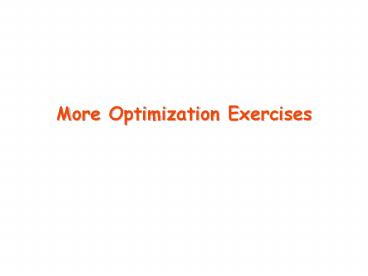More Optimization Exercises PowerPoint PPT Presentation
1 / 12
Title: More Optimization Exercises
1
More Optimization Exercises
2
Block Nested Loops Join
- Suppose there are B buffer pages
- Cost M ceil (M/(B-2))N where
- M is the number of pages of R
- N is the number of pages of S
foreach block of B-2 pages of R do foreach page
of S do for all matching in-memory pairs
r, s add ltr,sgt to result
3
Index Nested Loops Join
- Suppose there is an index on the join attribute
of S - We find the inner tuples using the index!
- Cost Read R once for each tuple in R, find the
appropriate tuples of S
foreach tuple r of R foreach tuple s of S
where risj add ltr,sgt to result
4
Sort-Merge Join
- Sort both relations on join attribute.
- This creates partitions according to the join
attributes. - Join relations while merging them. Tuples in
corresponding partitions are joined. - Cost depends on whether partitions are large and
therefore, are scanned multiple times. - In best case O(MNMlogM NlogN)
- Note that the log is not on base 2
5
Hash Join
//Partition R into k partitions foreach tuple r
in R do //flush when fills read r and add it
to buffer page h(ri) foreach tuple s in S do
//flush when fills read s and add it to buffer
page h(sj) for l 1..k //Build in-memory hash
table for Rl using h2 foreach tuple r in Rl
do read r and insert into hash table with h2
foreach tuple s in Sl do read s and probe table
using h2 output matching pairs ltr,sgt
Cost 3(M N), assuming there is enough buffer
space
6
Question 1
- Consider the query
- select
- from R, S
- where R.a lt S.b
- Can you use a variation on sort-merge join to
compute this query? what about hash join? index
nested loops join? block nested loops join?
7
Question 2
- Consider the query
- select
- from R, S
- where R.a S.b
- Suppose that b is a primary key in S
- R contains 10,000 tuples and 10 tuples per page
- S contains 2,000 tuples and 10 tuples per page
- There are 52 buffer pages
8
Question 2 (cont)
- Suppose that there are unclustered BTree indexes
on R.a and S.b. Is it cheaper to do an index
nested loop or block nested loop join? - Would the answer change if there were only 5
buffer pages - Would your answer change if S contained only 10
tuples?
9
Question 2 (cont)
- Suppose that there are clustered BTree indexes on
R.a and S.b. Is it cheaper to do an index nested
loop or block nested loop join? - Would the answer change if there were only 5
buffer pages - Would your answer change if S contained only 10
tuples?
10
Question 3
- Consider the query
- select E.eid
- from Employees E
- where E.age 25 and E.sal gt 3000 and
- E.sal lt5000
- Which index would you build in order to be able
to evaluate the query quickly? Hint A
multicolumn index
11
Question 4
- Consider the query
- select E.dno, COUNT()
- from Employees E
- group by E.dno
- Which index would you build in order to be able
to evaluate the query quickly? Hint Create an
index that allows avoiding access to the actual
Employee table
12
Question 5
- Consider the query
- select E.dno, MIN(E.sal)
- from Employees E
- group by E.dno
- Which index would you build in order to be able
to evaluate the query quickly? Hint Create an
index that allows avoiding access to the actual
Employee table

